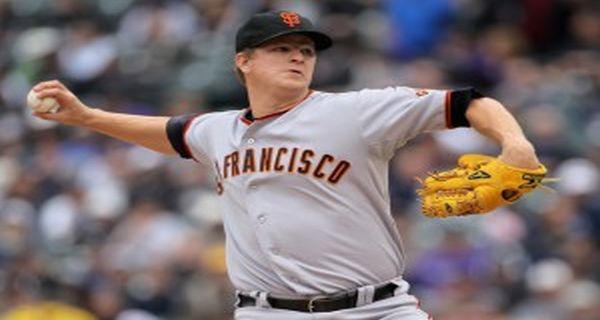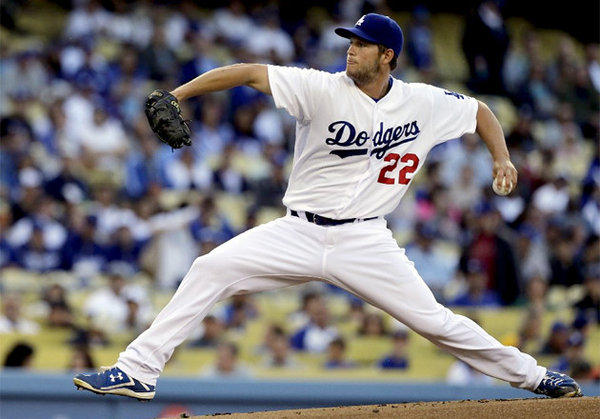2014 Fantasy Baseball: The Starting Pitching Market — NL West

It might be the golden age of starting pitching and we take a look at the National League West, we might see the best starting pitching in baseball. As we saw in the American League, there are plenty of first and second tier starting pitchers on the open market. We may not have had this deep of pitching availability since fantasy baseball has been a mainstream activity. Just in case you just joining us, let’s review over what we are doing here.
We are taking a look at every starting pitcher with at least 60 innings pitched. We are dividing these pitchers into three tiers based on their SIERA score. SIERA represents the best estimate of what a pitcher’s ERA should be based on a variety of factors. While we can’t look at every factor, we will look at the two most relevant statistics that help determine SIERA (strikeouts per nine innings and walks per nine innings) and the two statistics that help explain why a pitcher’s ERA might be higher or lower than his SIERA.
The first tier of starting pitchers have SIERAs lower than three. The second tier have SIERAs between three and four. The final tier have SIERAs higher than four. The whole idea is that you shouldn’t have to have pitchers from the third tier on your fantasy team. Either they are overachieving or you need to dump them in a hurry. Of course, the flip side is that we need to identify those tier one or two pitchers that are currently unowned or under-appreciated.
|
INN |
BABIP |
LOB% |
SO/9 |
BB/9 |
ERA |
SIERA |
|
|
64.1 |
.309 |
76.8 |
12.03 |
1.12 |
2.52 |
1.63 |
|
|
91.0 |
.313 |
83.0 |
9.59 |
1.98 |
2.57 |
2.83 |
|
|
94.2 |
.322 |
76.3 |
9.89 |
2.19 |
2.85 |
2.91 |
It’s funny how perceptions can be dead wrong. Before his recent no-hitter, a number of people thought Clayton Kershaw was having a down season. While he did spend some time on the disabled list, the rest of the numbers clearly indicate that he is all over it. His SIERA is clearly the lowest in baseball for those that qualify and it demonstrates that he will likely get better than he already is.
Meanwhile, his teammate is on the other end of the spectrum. He likely will taper off a bit based on his numbers, but we are still talking about a team with two tier one starters. They are currently running with two tier one starters and three tier two starters. In other words, it quite possibly is the best rotation in baseball and they are still behind the Giants. Obviously, pitching is not the issue in LA.
Out of all of the big time arms in San Francisco, Bumgarner is the only one that ended up being a tier one starter. Of course, they have others that have tier one ability and that is what is keeping them on top of the standings in the division. The key for all three of these guys is impeccable control. 2.19 walks per nine innings is the highest rate and that is considerably better than the league average.
|
INN |
BABIP |
LOB% |
SO/9 |
BB/9 |
ERA |
SIERA |
|
|
92.0 |
.331 |
65.4 |
7.63 |
1.66 |
5.18 |
3.02 |
|
|
101.0 |
.288 |
71.2 |
8.26 |
2.84 |
4.62 |
3.55 |
|
|
69.0 |
.284 |
73.3 |
6.39 |
3.39 |
3.52 |
3.99 |
|
|
86.1 |
.292 |
69.4 |
5.84 |
1.46 |
3.54 |
3.90 |
|
|
79.2 |
.232 |
86.4 |
8.59 |
2.71 |
2.49 |
3.41 |
|
|
76.1 |
.306 |
73.6 |
7.55 |
2.00 |
3.18 |
3.57 |
|
|
76.1 |
.284 |
75.1 |
6.96 |
2.59 |
2.36 |
3.66 |
|
|
92.0 |
.306 |
73.9 |
9.59 |
2.35 |
3.72 |
3.08 |
|
|
93.2 |
.292 |
71.7 |
8.65 |
3.84 |
3.27 |
3.47 |
|
|
94.0 |
.271 |
79.5 |
5.74 |
1.34 |
2.39 |
3.37 |
|
|
76.2 |
.324 |
72.3 |
8.92 |
3.99 |
4.81 |
3.81 |
|
|
80.0 |
.315 |
75.3 |
7.65 |
2.93 |
3.94 |
3.95 |
I’m not about to profile twelve different pitchers because that would take entirely too long. What you should focus on are the pitchers that have large gaps between their ERA and their SIERA. There are four pitchers on the list with ERAs and SIERAs separated by a full run or more. We start with Brandon McCarthy of the DIamondbacks. His ERA is more than two full runs higher than his SIERA. That is an indication of two things. First, the Dbacks have not done a good job of fielding behind him.
However, the more important second point is that he is due to bounce back. Therefore, if he is available in your league, you might consider snatching him up now. The same is also true of Wade Miley. The Dbacks are not a playoff contender, but they are also not this bad either. Both of the Arizona arms are due to bounce back. On the flip side, Tim Hudson and Andrew Cashner look like guys that you might want to deal if you possibly can. Both are solid pitchers and will continue to be solid, but they will not continue to be lights out as they have been. You should be able to find someone in your league that will take either one off of your hands and you may get more than a buck’s worth on the exchange.
|
INN |
BABIP |
LOB% |
SO/9 |
BB/9 |
ERA |
SIERA |
|
|
80.0 |
.268 |
67.9 |
5.40 |
2.25 |
4.05 |
4.42 |
|
|
86.0 |
.295 |
74.0 |
4.92 |
1.99 |
4.08 |
4.04 |
|
|
77.2 |
.261 |
68.4 |
6.95 |
4.29 |
4.75 |
4.36 |
|
|
75.0 |
.325 |
68.4 |
4.92 |
1.80 |
5.76 |
4.50 |
|
|
63.2 |
.249 |
67.6 |
6.93 |
3.39 |
4.52 |
4.25 |
Even though four of these five pitchers have better SIERAs than ERAs, none of them should be on your squad right now. If I had to add anyone it would probably be Eric Stults simply because of the significant difference in his SIERA and ERA. That being said, you shouldn’t have to. There are more than enough tier two starters available on the open market for you to have to play that kind of shell game.
The only significant name here is Matt Cain. It’s no mystery why he is here. When you look at tier three starters, they all have lower strikeout rates in common. Cain has gone from 7.92 in 2012 to 7.71 in 2013 to his current 6.93 rate. Why the numbers are dwindling no one knows, but clearly he is not the same guy he has been the past several seasons. His K rate has never dipped below seven per nine innings in any of his full seasons. Meanwhile, his walk rate hasn’t been that high since 2008. The SIERA numbers indicate he might get a little better, but he won’t be the pitcher that people expected him to be.




